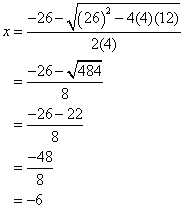Seriously! 11+ Little Known Truths on Quadratic Formula? For example, a cannot be 0, or the equation would be linear.
Quadratic Formula | In algebra, a quadratic equation is any polynomial equation of the second degree with the following form: Suppose, ax² + bx + c = 0 is the quadratic equation, then the formula to find the roots of this equation will be: The numerals a, b, and c are coefficients of the equation, and they represent known numbers. Ax 2 + bx + c = 0. Ax 2 + bx + c = 0.
See examples of using the formula to solve a variety of equations. Ax 2 + bx + c = 0. In algebra, a quadratic equation is any polynomial equation of the second degree with the following form: The quadratic formula is an algebraic formula used to solve quadratic equations. Where x is an unknown, a is referred to as the quadratic coefficient, b the linear coefficient, and c the constant.

Quadratic equations can be factored. − b ± √ b 2 − 4 a c. Zero, there is one real solution. Negative, there are 2 complex solutions. Khan academy is a 501(c)(3) nonprofit organization. To understand it, to value it, and to apply it correctly, you need to know a tiny bit of its background, then appreciate every term in it. Since quadratics have a degree equal to two, therefore there will be two solutions for the equation. There are other ways of solving a quadratic equation instead of using the quadratic formula, such as factoring (direct factoring, grouping, ac method), completing the square, graphing and others. Quadratic equation in standard form: Then, we plug these coefficients in the formula: Solve an equation of the form a x 2 + b x + c = 0 by using the quadratic formula: In elementary algebra, the quadratic formula is a formula that provides the solution(s) to a quadratic equation.there are other ways of solving a quadratic equation instead of using the quadratic formula, such as factoring (direct factoring, grouping, ac method), completing the square, graphing and others. X = −b ± √ (b2 − 4ac) 2a.
Quadratic equations can be factored. For the quadratic formula to work, you must have your equation arranged in the form (quadratic) = 0.also, the 2a in the denominator of the formula is underneath everything above, not just the square root.and it's a 2a under there, not just a plain 2.make sure that you are careful not to drop the square root or the plus/minus in the middle of your calculations, or i can guarantee that. The quadratic formula helps us solve any quadratic equation. Ax 2 + bx + c = 0. The calculator solution will show work using the quadratic formula to solve the entered equation for real and complex roots.

X = −b ± √ (b2 − 4ac) 2a. First, we bring the equation to the form ax²+bx+c=0, where a, b, and c are coefficients. Given a general quadratic equation of the form en.wikipedia.org The quadratic formula is a milestone along the path to fully understanding algebra. Quadratic equations can be factored. Ax 2 + bx + c = 0. Negative, there are 2 complex solutions. See examples of using the formula to solve a variety of equations. In elementary algebra, the quadratic formula is a formula that provides the solution(s) to a quadratic equation. Quadratic equation in standard form: Since quadratics have a degree equal to two, therefore there will be two solutions for the equation. Then, we plug these coefficients in the formula: − b ± √ b 2 − 4 a c.
In elementary algebra, the quadratic formula is a formula that provides the solution(s) to a quadratic equation. There are other ways of solving a quadratic equation instead of using the quadratic formula, such as factoring (direct factoring, grouping, ac method), completing the square, graphing and others. The formula for a quadratic equation is used to find the roots of the equation. Negative, there are 2 complex solutions. Khan academy is a 501(c)(3) nonprofit organization.

There are other ways of solving a quadratic equation instead of using the quadratic formula, such as factoring (direct factoring, grouping, ac method), completing the square, graphing and others. In algebra, a quadratic equation is any polynomial equation of the second degree with the following form: Negative, there are 2 complex solutions. Zero, there is one real solution. Ax 2 + bx + c = 0. See examples of using the formula to solve a variety of equations. X = −b ± √ (b2 − 4ac) 2a. For example, a cannot be 0, or the equation would be linear. Since quadratics have a degree equal to two, therefore there will be two solutions for the equation. Suppose, ax² + bx + c = 0 is the quadratic equation, then the formula to find the roots of this equation will be: Given a general quadratic equation of the form Then, we plug these coefficients in the formula: Ax 2 + bx + c = 0.
Ax 2 + bx + c = 0 quad. The calculator solution will show work using the quadratic formula to solve the entered equation for real and complex roots.
Quadratic Formula: The numerals a, b, and c are coefficients of the equation, and they represent known numbers.

Post a Comment
Post a Comment